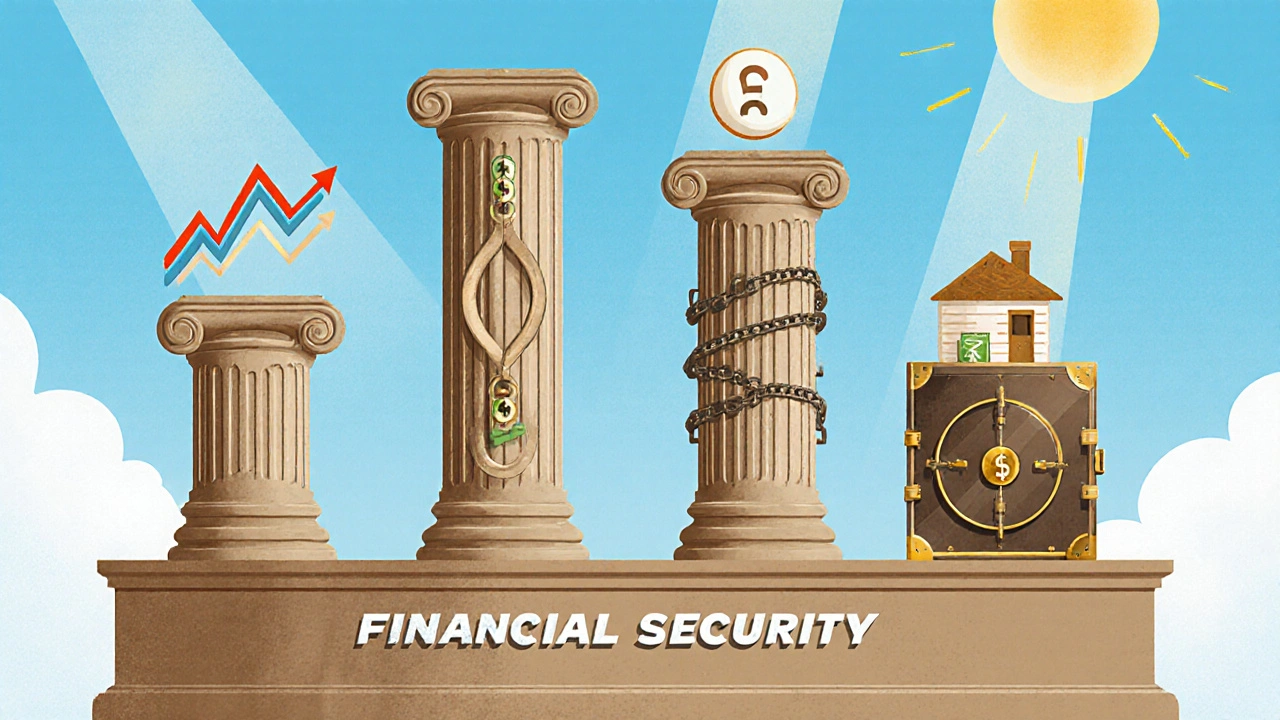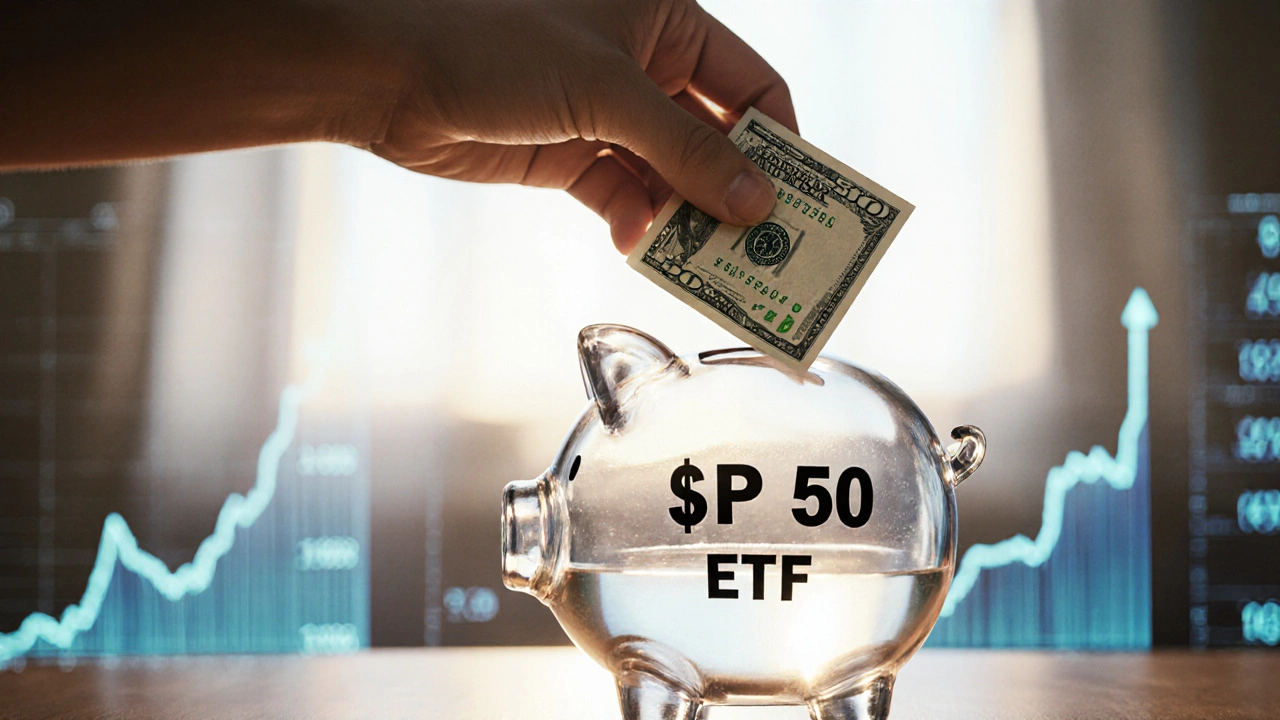Most people think financial security means having a big savings account. But if you only save money without investing it, inflation quietly eats away at your power. A dollar saved today is worth less tomorrow. That’s why investments aren’t optional-they’re the foundation of real financial freedom.
What Investments Actually Do
Investments turn money into work for you. Instead of trading hours for dollars, you put cash to work buying pieces of businesses, real estate, or government promises. Over time, those pieces grow in value or pay you back through dividends, rent, or interest. It’s not magic-it’s math. The S&P 500, for example, has returned about 10% annually over the last 90 years, even after crashes and recessions. That’s not a guess. It’s data from the Federal Reserve and Yale’s Shiller database.
People who wait to "save enough" before investing often never start. They think they need $10,000 or a bonus check. But you don’t. You need $50. A single share of an S&P 500 ETF costs less than $500. Many brokers let you buy fractions of shares. Start small. Start now. Time is your biggest advantage.
The Four Core Building Blocks
Every solid financial plan rests on four types of investments. Missing one weakens the whole structure.
- Stocks - Ownership in companies. They’re volatile in the short term but have delivered the highest returns over decades. Think Apple, Microsoft, or low-cost index funds tracking the whole market.
- Bonds - Loans to governments or corporations. They pay fixed interest and are less risky than stocks. U.S. Treasury bonds are the safest. Corporate bonds offer higher yields but come with more risk.
- Real Estate - Physical property or REITs (Real Estate Investment Trusts). Rent checks keep coming even when the stock market drops. A rental house in a growing city can pay for itself in 10-15 years.
- Cash Equivalents - High-yield savings accounts, money market funds, short-term CDs. These aren’t growth engines, but they’re your emergency buffer. Keep 3-6 months of expenses here.
Putting all your money in stocks is like driving with no brakes. Putting it all in savings is like parking the car forever. Balance matters.
Asset Allocation: Your Personal Recipe
There’s no one-size-fits-all mix. Your ideal portfolio depends on your age, goals, and tolerance for risk.
A 25-year-old might put 80% in stocks, 15% in bonds, and 5% in cash. Why? They have time to ride out crashes. A 60-year-old planning to retire in five years might flip that: 40% stocks, 50% bonds, 10% cash. Their goal isn’t growth-it’s stability.
This isn’t guesswork. The 60/40 portfolio (60% stocks, 40% bonds) has been the standard for decades because it balances growth and safety. But you can tweak it. If you’re comfortable with swings, go heavier on stocks. If a 10% drop keeps you up at night, add more bonds.
Rebalance once a year. Sell what’s grown too much, buy what’s fallen. It forces you to buy low and sell high-without emotions.

Why Most People Fail at Investing
It’s not because they’re bad with money. It’s because they act on fear and greed.
When the market drops 20%, 70% of retail investors panic and sell, according to Dalbar’s annual study. Then they miss the rebound. The market recovered 27% in 2020 after the pandemic crash. Those who sold lost that gain-and never got back in.
Another trap? Chasing hot stocks. Tesla, Bitcoin, meme stocks-they make headlines. But betting your future on one company or crypto is gambling, not investing. The average lifespan of a top-performing stock is under five years. Index funds don’t make headlines. But they make wealth.
And then there’s cost. A 1% annual fee on a $100,000 portfolio eats $1,000 a year. Over 30 years, that’s more than $150,000 lost to fees. Low-cost index funds charge 0.03%-0.10%. That’s the difference between retiring rich and retiring broke.
How to Start Without a Financial Advisor
You don’t need a fancy advisor. You need a plan and discipline.
- Open a brokerage account at Fidelity, Vanguard, or Charles Schwab. All offer $0 commissions and no minimums.
- Set up automatic transfers. $100 a week. $500 a month. Doesn’t matter. Just be consistent.
- Buy a total stock market index fund like VTI or VTSMX. It holds thousands of U.S. companies in one click.
- Buy a total bond market fund like BND to balance it.
- Set reminders to rebalance every December.
That’s it. No stock picks. No timing the market. No watching tickers all day. Just steady, simple investing.

Real People, Real Results
Meet Sarah, 32. She started investing $300 a month at 25. She didn’t touch it. She didn’t panic in 2008 or 2020. She kept going. Today, she has $187,000. She didn’t win the lottery. She just let compound interest do its job.
Meet James, 58. He started at 45 with $20,000. He put it into a 60/40 portfolio. He added $200 a month. He didn’t chase trends. He stayed calm. He retired at 60 with $420,000. He didn’t need a big salary. He needed consistency.
These aren’t outliers. They’re normal people who did the boring thing right.
What Comes Next
Investing isn’t about getting rich quick. It’s about staying secure long-term. It’s about knowing your family won’t lose their home if you get sick. It’s about retiring without begging for help.
Start today. Even if it’s $25. Even if you’re scared. The market doesn’t care if you’re ready. It keeps moving. Your job? Show up, stay calm, and keep adding.
Financial security isn’t a destination. It’s a daily habit. And investments? They’re the only tool that turns small, regular actions into lasting freedom.
Do I need a lot of money to start investing?
No. You can start with as little as $10. Many brokers let you buy fractional shares of ETFs or stocks. The key isn’t how much you start with-it’s that you start and keep going. Consistency beats size every time.
Are stocks too risky for beginners?
Stocks can be volatile, but index funds spread risk across hundreds or thousands of companies. A total market fund like VTI holds everything from Apple to small local businesses. Over 20+ years, the odds of losing money drop to near zero. Risk isn’t about short-term swings-it’s about not investing at all and losing to inflation.
Should I invest in crypto instead of stocks?
Crypto is speculative, not an investment. It doesn’t generate cash flow like dividends or rent. It’s driven by hype, not fundamentals. If you want to allocate a small portion (under 5%) for curiosity, fine. But don’t rely on it for your financial security. Stocks and bonds have 100+ years of proven history. Crypto has less than 15.
What’s the best time to invest?
The best time was 20 years ago. The second best is today. Trying to time the market means you have to be right twice-when to get in and when to get out. Most people get it wrong. Dollar-cost averaging-investing the same amount regularly-removes the guesswork. You buy more when prices are low, less when they’re high.
How do I know if I’m on track?
Use the 1x your salary rule by age 30, 3x by 40, 6x by 50, and 10x by 60. That’s a guideline from Fidelity. But more important: Are you investing at least 15% of your income? Are you avoiding high fees? Are you staying calm during downturns? If yes, you’re ahead of 90% of people.
Don’t wait for the perfect moment. There isn’t one. The perfect moment is now-with what you have, where you are.



sonny dirgantara
October 27, 2025 AT 18:55started with 20 bucks on robinhood lol. still got it. no cap.
Jawaharlal Thota
October 28, 2025 AT 00:55Let me tell you something, friend - investing isn’t about waiting for some magical windfall or a perfect moment that never comes. It’s about showing up, day after day, even when the market feels like it’s laughing at you. I started with ₹500 a month in India, buying SIPs in index funds, and now, ten years later, I’ve built a nest egg that lets me breathe easier than I ever thought possible. You don’t need to be rich to begin. You just need to be consistent. The math doesn’t lie. Compounding doesn’t care if you’re nervous. It only cares if you stay in the game. So set up that auto-transfer. Buy that fractional share. Let your money work while you sleep. The world doesn’t reward the loudest - it rewards the most persistent.
Lauren Saunders
October 29, 2025 AT 12:34It’s amusing how this post reduces investing to a series of bullet points like it’s a TED Talk for suburban millennials. The S&P 500’s historical returns? Sure. But they ignore structural inequality, tax policy shifts, and the fact that most Americans can’t afford $50 after rent, utilities, and student loans. Also, ‘low-cost index funds’ - charmingly naive. Have you seen the expense ratios on Vanguard’s retail funds lately? And don’t get me started on the myth of ‘dollar-cost averaging’ in a Fed-driven asset bubble. This isn’t finance. It’s financial wellness propaganda.
Johnathan Rhyne
October 29, 2025 AT 19:41Oh wow, another ‘invest in index funds’ sermon. How original. You know what’s better than the S&P 500? Shorting it. The market’s rigged. Inflation’s not ‘eating’ your money - the Fed is printing it like it’s Monopoly cash. Real wealth isn’t in ETFs - it’s in gold, land, and cash under the mattress. Also, ‘fractional shares’? That’s just Wall Street’s way of turning teenagers into gamblers with their parents’ debit cards. I’ve been rich for 20 years and never owned a single stock. I own a bar in Austin. Cash flow, baby. Not beta.
Nathan Jimerson
October 31, 2025 AT 13:20I know it sounds simple, but starting small really does work. I was working two part-time jobs, living with my parents, and putting in $25 a week. Five years later, I had over $15,000. Not because I got lucky - because I didn’t stop. Even on bad days, I kept going. That’s the secret. Not genius. Not timing. Just showing up.
Janiss McCamish
November 1, 2025 AT 19:55Real talk: if you’re waiting for ‘enough’ money, you’ll never start. The only thing worse than losing money is losing time. Start now. Even $10. Even $5. The market doesn’t care how much you have - it cares that you’re there.
Richard H
November 2, 2025 AT 09:52Who the hell wrote this? Some finance bro who thinks America’s the only country that matters? India’s got its own index funds. China’s got ETFs. Europe’s got bonds. And you’re telling people to buy VTI like it’s the Ten Commandments? This isn’t investing - it’s American financial colonialism wrapped in a PowerPoint.
Kendall Storey
November 2, 2025 AT 18:45Let’s cut through the noise - this is a textbook example of passive investing done right. Index funds = exposure to the entire equity market with minimal friction. No stock-picking, no emotional triggers, no FOMO. The 60/40 isn’t outdated - it’s the baseline for risk-adjusted returns. Rebalancing is your secret weapon. And yes, fees matter. A 1% fee over 30 years can erase 40% of your terminal value. That’s not a suggestion - it’s arithmetic. Do the math. Then automate it.
Ashton Strong
November 2, 2025 AT 22:22It is with the utmost sincerity and profound respect for the principles of financial prudence that I commend the author for articulating, with remarkable clarity, the foundational tenets of long-term wealth accumulation. The emphasis on consistency, low-cost indexation, and the psychological discipline required to endure market volatility is not merely advisable - it is, in my view, indispensable to the preservation and growth of capital in an era of unprecedented monetary expansion. One must not underestimate the transformative power of small, regular contributions compounded over time - a truth as immutable as the laws of thermodynamics.
Steven Hanton
November 3, 2025 AT 07:51I appreciate the structure here. The four building blocks are well-defined. I’d only add that people often overlook the emotional component - it’s not about knowing what to buy, it’s about knowing when not to sell. The real challenge isn’t the market. It’s yourself. I’ve seen brilliant people lose everything because they panicked during a 12% dip. Discipline is the silent edge.
Pamela Tanner
November 4, 2025 AT 13:40Minor grammatical note: ‘a dollar saved today is worth less tomorrow’ should be ‘a dollar saved today is worth less than it was yesterday.’ Also, ‘investments aren’t optional-they’re’ needs a space after the hyphen. But the message? Spot on. Start small. Stay consistent. Ignore the noise.
King Medoo
November 5, 2025 AT 23:11They don’t want you to know this - but index funds are a trap. The Fed owns 20% of the S&P 500 through ETFs. They’re manipulating prices to keep the middle class docile. And ‘dollar-cost averaging’? That’s just a way to make you buy high during rallies and then feel guilty when it crashes. I bought Bitcoin in 2017, sold at $68k, then bought gold and land. Now I live off-grid. They’re printing money. You’re being played. Wake up. 🤡
Rae Blackburn
November 7, 2025 AT 15:31Did you know the government tracks your brokerage account and uses your investments to predict your political views? They’re using your 401k to build a social credit score. I stopped investing. Now I keep cash in a safe. I don’t trust any of this. They’re coming for your money next
LeVar Trotter
November 9, 2025 AT 03:46Let’s talk about asset allocation beyond the 60/40. The real alpha comes from tactical tilts - overweighting small-cap value, adding REITs for inflation hedging, and using tactical bond duration shifts when the yield curve inverts. Most retail investors don’t even know what a TIPS bond is. You can’t just buy VTI and call it a day. You need to understand duration, convexity, and correlation matrices. If you’re not rebalancing quarterly with tax-loss harvesting, you’re leaving 1-2% annual returns on the table. This isn’t just investing - it’s financial engineering.